Introduction:
Ornamental gravels and other decorative surface dressings
These decorative surface dressings should be laid in much the same way as that shown on the Gravel Surfaces page.
There's been a surge in interest about modern, ornamental gravels and surface dressings in the past few years, primarily for garden design where some bold statement or design theme is being made. All of these ornamental surface dressings are vastly more expensive than a standard 'pea-gravel' available from a Builders' Merchant, but the preparation and methodology of construction are exactly the same as given above.
The four most commonly specified ornamental surface dressings are:-
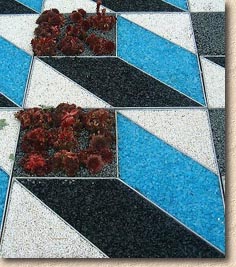
- - slate mulch
- - coloured gravel
- - tumbled glass
- - metallic nodules
Slate Mulch
Despite its trendy image and price tag to match, this stuff is actually the waste by-product from hundreds of years of roofing slate production. 20 years ago, the quarry owners could barely give it away, but now, thanks to the influence of TV Home Improvement programmes, it's been given a new respectability.
See also Slate Paving page Different colours are available, depending on where the slate is originally sourced, but the commonest colours are blues, purples and greens. Very trendy, but not the easiest surface to walk upon. Coverage is around 0.4m² per 40Kg bag at 30mm deep.
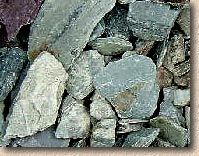
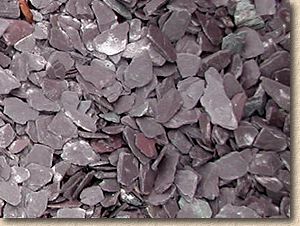
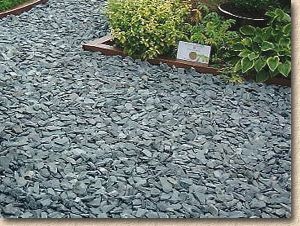
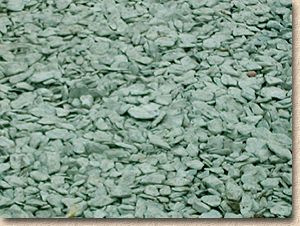
Used as mulches or in decorative areas, slate forms an attractive dressing, but when it's used for areas subject to vehicular traffic, its inherent brittleness means that it tends to get crushed down to a dust quite quickly. Now, this may not be a bad thing, as the dust generated acts as a binder and knits together the larger pieces, creating a sturdy, trafficable surface.
For decorative uses, the tumbled and washed slate is a better choice as it has had all sharp edges nullified and the claggy dust washed away, leaving an attractive, colourful, highly textured covering.
Coloured Gravels
These come in two main types - those that are made from a naturally coloured rock, such as a white marble or green basalt, and those that are covered with a coloured coating, such as "Coloreis®" which is basically painted limestone chippings. Usually in 6mm or 10mm sizes, although there are graded ranges available, such as 4-10mm, as well as larger 20mm or bigger gravels.
Special colours are manufactured, often for incorporation in a bound surface dressing (see Resin Bonded Paving ) as well as selected gravels of a guaranteed hardness. Some Green and Red coloured aggregates are now being used to de-lineate cycleways and other traffic lanes, as well as being used in creative landscape designs.
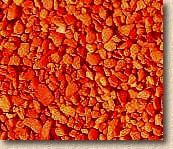
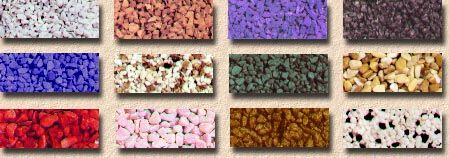
hese products tend to be quite expensive; the artificially coloured stones, even at trade prices, are often 10 times the price of a 'natural' gravel, so be prepared for your pockets to be emptied. Prices of £300-£1,000 plus VAT per tonne are not uncommon for the artificially coloured aggregates, while the imported naturally coloured products may be £200-£600, plus VAT. And with coverage in the region of 15-20m² per tonne at 35mm deep, the cost can soon reach £50 per square metre, or more than three times the price of buying, say, block paving bricks. You have been warned!
Tumbled Glass
This type of product is made in a number of ways, but they all tend to be 'tumbled' in some way to remove any sharp edges, resulting in nodules that are rounded, very much like a marine gravel or a pebble on the beach. Colours are limited only by the colour of the starter glass, so blues, browns and greens tend to be popular, as well as 'clear'.
Comes in a variety of sizes, from 1mm granules up to 10 or 12mm pebbles and even bigger 20-30mm 'beads'. Again, very expensive, as much as £500 per tonne!
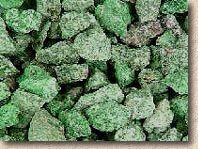
Metallic Nodules
I'm tempted to call these products 'Metal Filings', as that's what they are, basically, if a little bigger. The two most commonly seen decorative metal nodules are Copper and Aluminium, and, while they may be a little OTT for large areas of paving, they are superb for detailing prestigious paving.
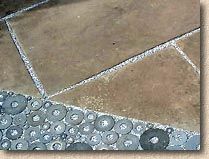
Unlike the coloured gravels and tumbled glasses, which are laid, like 'normal' gravels at around 30-40mm thick, these metal dressings are laid just thick enough to cover the surface, usually around 6mm - a 30mm thick layer of copper granules would be a major temptation to the local wealth redistribution agents (thieves).
At 4-8mm average depth of cover, 1-3mm copper covers approximately 4 m² per 100Kg, while at a similar thickness, 6mm aluminium will cover approximately 7.5 m² per 100Kg. Price depends on quantity, but can be very, very expensive - I've seen prices of £5-£50 per Kg over the past 12 months


